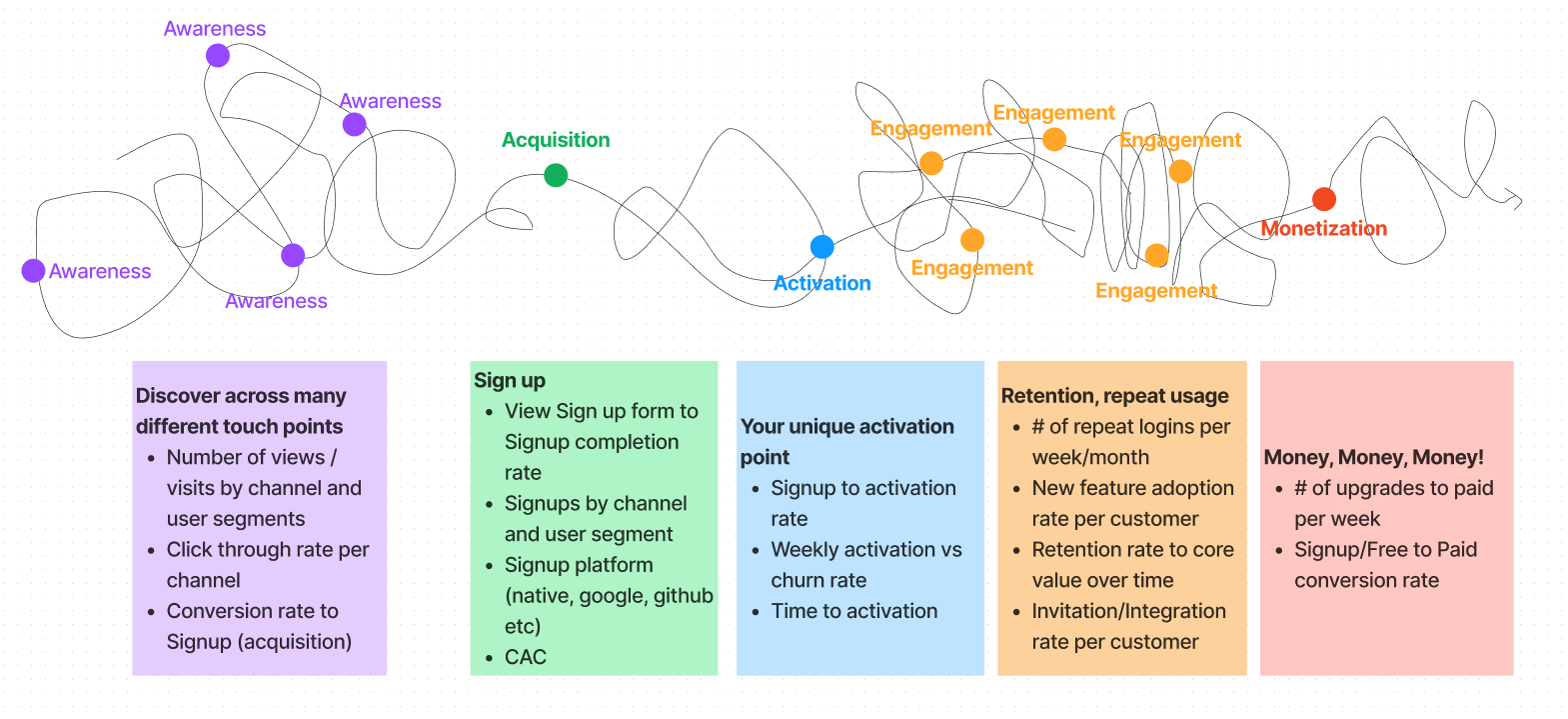Key PLG Metrics

We often talk about the user funnel or user ladder to show users’ movement across Awareness, Acquisition, Engagement, and Monetization. In my opinion, that’s an oversimplification of a journey a user goes through. Their path is not straightforward. While I get that it’s much easier to talk in terms of a simplistic user funnel, this limits our thinking in finding ways to engage users.
A user’s journey to interact with a brand/company/product is a lot more complex and often unpredictable. For e.g. you may have a hundred touchpoints during the awareness phase and still not be able to get users to sign up. On the other hand, a user may sign up after their first touch point. A key difference in the product-led growth (or PLG) approach is that you are using an impact-driven approach. So, as long as you identify key metrics along key milestones in a user journey, you can create initiatives to drive more users toward similar metric outcomes.
In this write-up, I am going to talk about a few key SaaS-based PLG metrics across the user journey.
Awareness: Your goal here is to get users to discover your product, get them interested in the value proposition, and eventually take action to move towards the acquisition. The following metrics will help measure some of those activities. (I use Google Analytics comes closest to tracking these metrics.)
- Number of visits/views by channels and user segments
- Click-through rate per channel
- Conversion rate to Signup (Acquisition)
Acquisition: In most cases, the acquisition is the same as signup but can be different for specific industries or tools. For e.g., if you are running an open-source project, this could also be forking your repo.
Through the Awareness phase, you have gotten a user’s attention and got them to like your value proposition enough to have them come to your signup page and complete the step. Now, the goal is to get them over the hump to a personalized experience. Here, you are tracking:
- View Signup form to signup completion rate (change signup to whatever your acquisition point is)
- Signups by referral channel and user segment
- Signups broken down by authentication platforms (Native, Google, Github, Facebook, etc)
- Customer Acquisition Cost (CAC)
Activation: Companies often struggle with their activation point. An activation point (or aha moment!) can sometimes be a moving target during the early stages of a product’s journey. You want to define your activation point where a new user has experienced the core value position of your solution. You want users to get to that point as soon as possible, often referred to as time to value. The following metrics will help evaluate activations for your product (We use Amplitude to track all things inside the Sentry app):
- Signup for activation rate
- Time to activation
- Weekly activation vs churn rate: This will give a good indication of the overall company’s health
Engagement: This is probably the longest cycle and the most convoluted part. You want your users to keep coming back to your product to get the core value, then adopt additional value and features. Thus, putting in a virtuous cycle towards monetization. This will continue to help your product stick and build a higher barrier to entry for your competition. The metrics, here, are:
- # of repeat logins per week/month
- New feature adoption rate per customer
- Retention rate on core value proposition page
- Invitation/Integration rate per customer
Monetization: Through all the early efforts, you are eventually hoping that users upgrade to a premium tier and get all the more value out of your product. These are far fewer customers compared to the overall base. Some users will get enough value just out of the free tier and that’s fine. Key metrics to track here are:
- # of Paid upgrades per week/month
- Signup/Free to Upgrade conversion rate
- Paid tier segmentation and conversions
In summary, Identify what are key threshold points that keep pushing users along their journey to stickiness and monetization. You can evaluate progress through the above mentioned PLG metrics at each of the key milestones.